Page 367 of 415
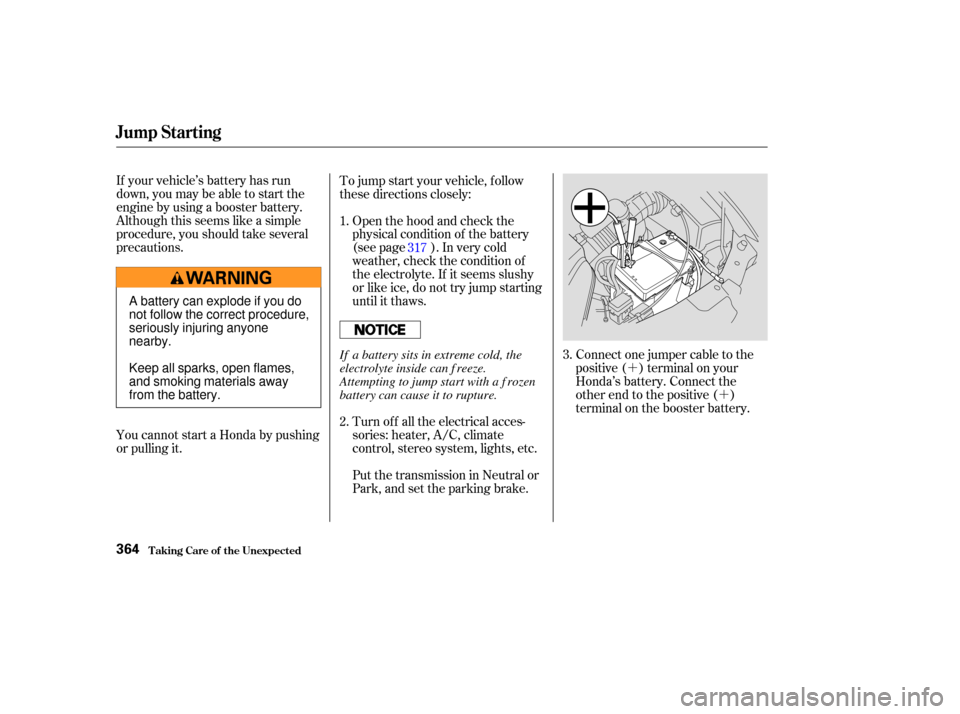
�´�´
If your vehicle’s battery has run
down,youmaybeabletostartthe
engine by using a booster battery.
Although this seems like a simple
procedure, you should take several
precautions.
You cannot start a Honda by pushing
or pulling it. To jump start your vehicle, f ollow
these directions closely:
Open the hood and check the
physical condition of the battery
(see page ). In very cold
weather, check the condition of
the electrolyte. If it seems slushy
or like ice, do not try jump starting
until it thaws.
Turn of f all the electrical acces-
sories: heater, A/C, climate
control, stereo system, lights, etc.
Put the transmission in Neutral or
Park, and set the parking brake. Connect one jumper cable to the
positive ( ) terminal on your
Honda’s battery. Connect the
other end to the positive ( )
terminal on the booster battery.
1.
2.
3.
317
T aking Care of t he Unexpect ed
Jump Starting
364
A battery can explode if you do
not follow the correct procedure,
seriously injuring anyone
nearby.
Keep all sparks, open flames,
and smoking materials away
from the battery.
If a battery sits in extreme cold, the
electrolyte inside can f reeze.
Attempting to jump start with a f rozen
battery can cause it to rupture.
Page 369 of 415
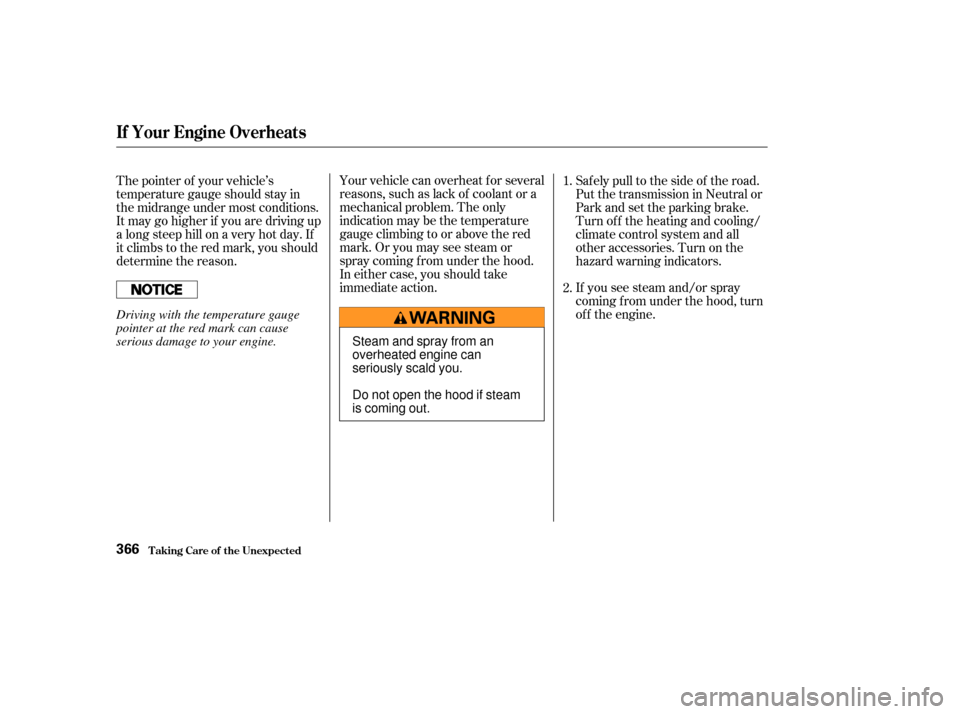
Your vehicle can overheat for several
reasons, such as lack of coolant or a
mechanical problem. The only
indication may be the temperature
gauge climbing to or above the red
mark. Or you may see steam or
spray coming f rom under the hood.
In either case, you should take
immediate action.Saf ely pull to the side of the road.
Put the transmission in Neutral or
Park and set the parking brake.
Turn of f the heating and cooling/
climate control system and all
otheraccessories.Turnonthe
hazard warning indicators.
If you see steam and/or spray
coming f rom under the hood, turn
of f the engine.
The pointer of your vehicle’s
temperature gauge should stay in
the midrange under most conditions.
Itmaygohigherif youaredrivingup
a long steep hill on a very hot day. If
it climbs to the red mark, you should
determine the reason.
1.
2.
If Your Engine Overheats
T aking Care of t he Unexpect ed366
Steam and spray from an
overheated engine can
seriously scald you.
Do not open the hood if steam
is coming out.
Driving with the temperature gauge
pointer at the red mark can cause
serious damage to your engine.
Page 370 of 415
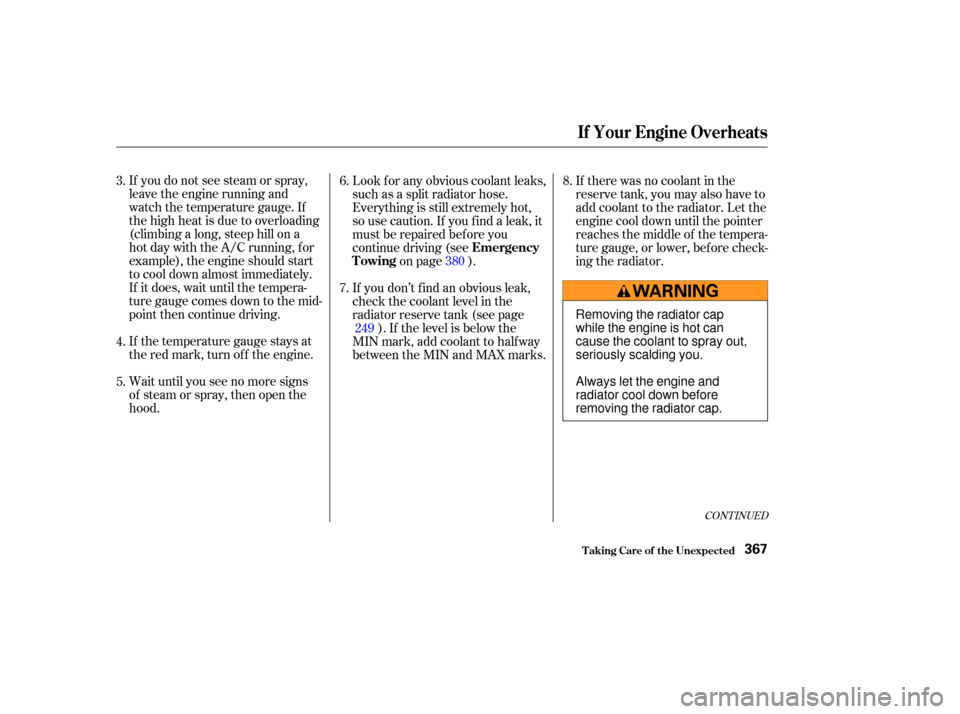
If you do not see steam or spray,
leave the engine running and
watch the temperature gauge. If
the high heat is due to overloading
(climbing a long, steep hill on a
hot day with the A/C running, f or
example), the engine should start
to cool down almost immediately.
If it does, wait until the tempera-
ture gauge comes down to the mid-
point then continue driving.
If the temperature gauge stays at
the red mark, turn of f the engine.
Wait until you see no more signs
of steam or spray, then open the
hood.Look f or any obvious coolant leaks,
such as a split radiator hose.
Everything is still extremely hot,
so use caution. If you f ind a leak, it
must be repaired bef ore you
continue driving (see
on page ).
If you don’t f ind an obvious leak,
check the coolant level in the
radiator reserve tank (see page ). If the level is below the
MIN mark, add coolant to halfway
between the MIN and MAX marks. If there was no coolant in the
reserve tank, you may also have to
add coolant to the radiator. Let the
engine cool down until the pointer
reaches the middle of the tempera-
ture gauge, or lower, bef ore check-
ing the radiator.
3.
7. 6.
5. 4. 380
249 8.
CONT INUED
Emergency
Towing
If Your Engine Overheats
T aking Care of t he Unexpect ed367
Removing the radiator cap
while the engine is hot can
cause the coolant to spray out,
seriously scalding you.
Always let the engine and
radiator cool down before
removing the radiator cap.
Page 372 of 415
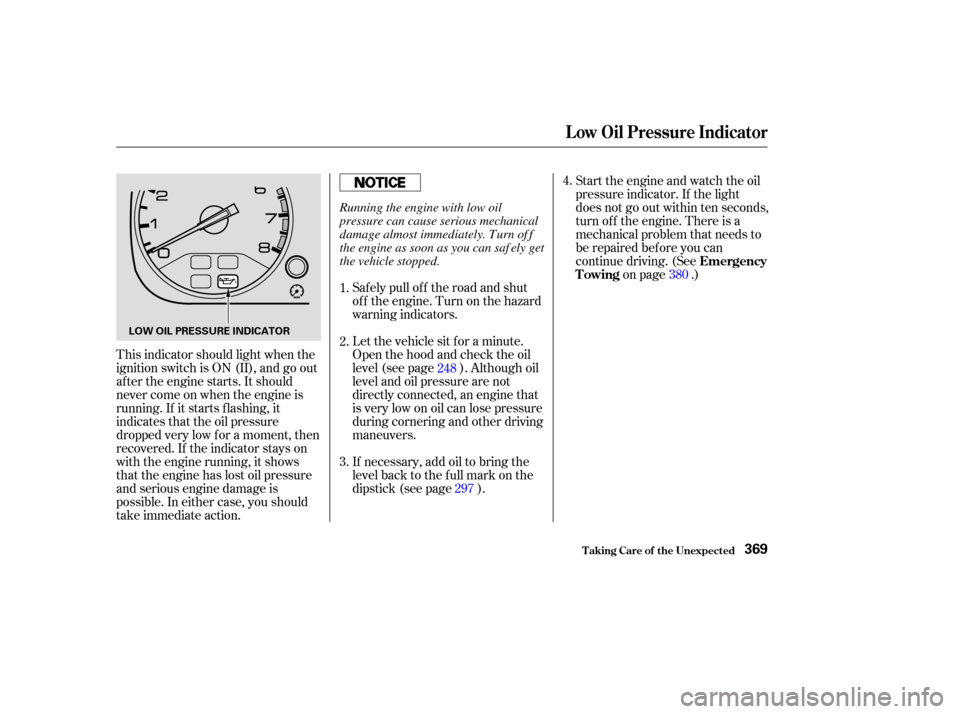
This indicator should light when the
ignition switch is ON (II), and go out
af ter the engine starts. It should
never come on when the engine is
running. If it starts f lashing, it
indicates that the oil pressure
dropped very low f or a moment, then
recovered. If the indicator stays on
with the engine running, it shows
that the engine has lost oil pressure
and serious engine damage is
possible. In either case, you should
take immediate action.Saf ely pull of f the road and shut
of f the engine. Turn on the hazard
warning indicators.
If necessary, add oil to bring the
level back to the full mark on the
dipstick (see page ). Let the vehicle sit f or a minute.
Open the hood and check the oil
level (see page ). Although oil
levelandoilpressurearenot
directly connected, an engine that
is very low on oil can lose pressure
during cornering and other driving
maneuvers.Start the engine and watch the oil
pressure indicator. If the light
does not go out within ten seconds,
turn of f the engine. There is a
mechanical problem that needs to
be repaired bef ore you can
continue driving. (See
on page .)
1.
2.
3. 4.
248 297 380
Emergency
Towing
L ow Oil Pressure Indicator
T aking Care of t he Unexpect ed369
LOW OIL PRESSURE INDICATOR
Running the engine with low oil
pressure can cause serious mechanical
damage almost immediately. Turn of f
the engine as soon as you can saf ely get
the vehicle stopped.
Page 377 of 415
All the electrical circuits in your
vehicle have fuses to protect them
f rom a short circuit or overload.
These f uses are located in f our f use
boxes.
Theinteriorfuseboxesarelocated
underneath the dashboard on each
side.Toopenthefuseboxonthe
passenger’s side, pull the right edge
of the cover.
The primary under-hood f use box is
locatedinthebackof theengine
compartment on the passenger’s side.
To open it, push the tabs as shown.
Fuses
T aking Care of t he Unexpect ed374
DRIVER’S SIDE INTERIOR PASSENGER’S SIDE
INTERIOR
PRIMARY UNDER-HOOD FUSE BOX
Page 409 of 415
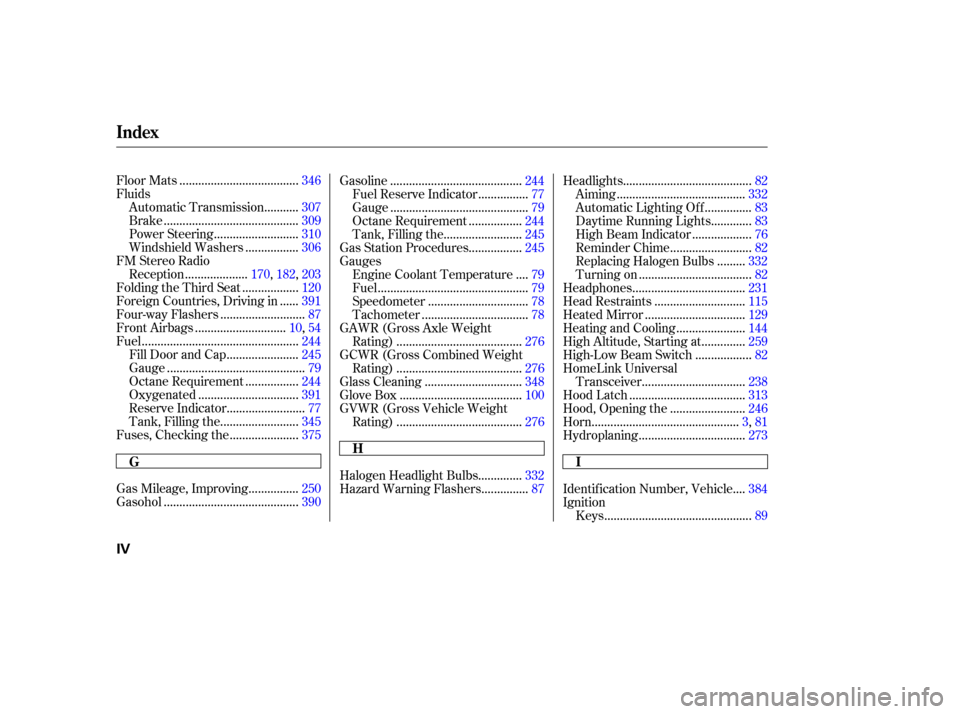
.....................................
Floor Mats .346
Fluids ..........
Automatic Transmission . 307
..........................................
Brake .309
..........................
Power Steering .310
................
Windshield Washers . 306
FM Stereo Radio ...................
Reception . 170,182,203
.................
Folding the Third Seat . 120
.....
Foreign Countries, Driving in . 391
..........................
Four-way Flashers .87
............................
Front Airbags .10, 54
.................................................
Fuel .244
......................
Fill Door and Cap .245
...........................................
Gauge .79
................
Octane Requirement . 244
...............................
Oxygenated .391
........................
Reserve Indicator .77
........................
Tank, Filling the .345
.....................
Fuses, Checking the .375
...............
Gas Mileage, Improving . 250
..........................................
Gasohol .390 .........................................
Gasoline .244
...............
Fuel Reserve Indicator . 77
...........................................
Gauge .79
................
Octane Requirement . 244
........................
Tank, Filling the .245
................
Gas Station Procedures . 245
Gauges ...
Engine Coolant Temperature . 79
...............................................
Fuel .79
...............................
Speedometer .78
.................................
Tachometer .78
GAWR (Gross Axle Weight .......................................
Rating) .276
GCWR (Gross Combined Weight .......................................
Rating) .276
..............................
Glass Cleaning .348
......................................
Glove Box .100
GVWR (Gross Vehicle Weight .......................................
Rating) .276
...
Identif ication Number, Vehicle . 384
Ignition ..............................................
Keys .89
.............
Halogen Headlight Bulbs . 332
..............
Hazard Warning Flashers . 87........................................
Headlights .82
........................................
Aiming .332
..............
Automatic Lighting Off . 83
............
Daytime Running Lights . 83
..................
High Beam Indicator . 76
.........................
Reminder Chime .82
........
Replacing Halogen Bulbs . 332
...................................
Turning on .82
...................................
Headphones .231
............................
Head Restraints .115
...............................
Heated Mirror .129
.....................
Heating and Cooling .144
.............
High Altitude, Starting at . 259
.................
High-Low Beam Switch . 82
HomeLink Universal ................................
Transceiver .238
....................................
Hood Latch .313
.......................
Hood, Opening the .246
..............................................
Horn .3,81
.................................
Hydroplaning .273
Index
G H
I
IV